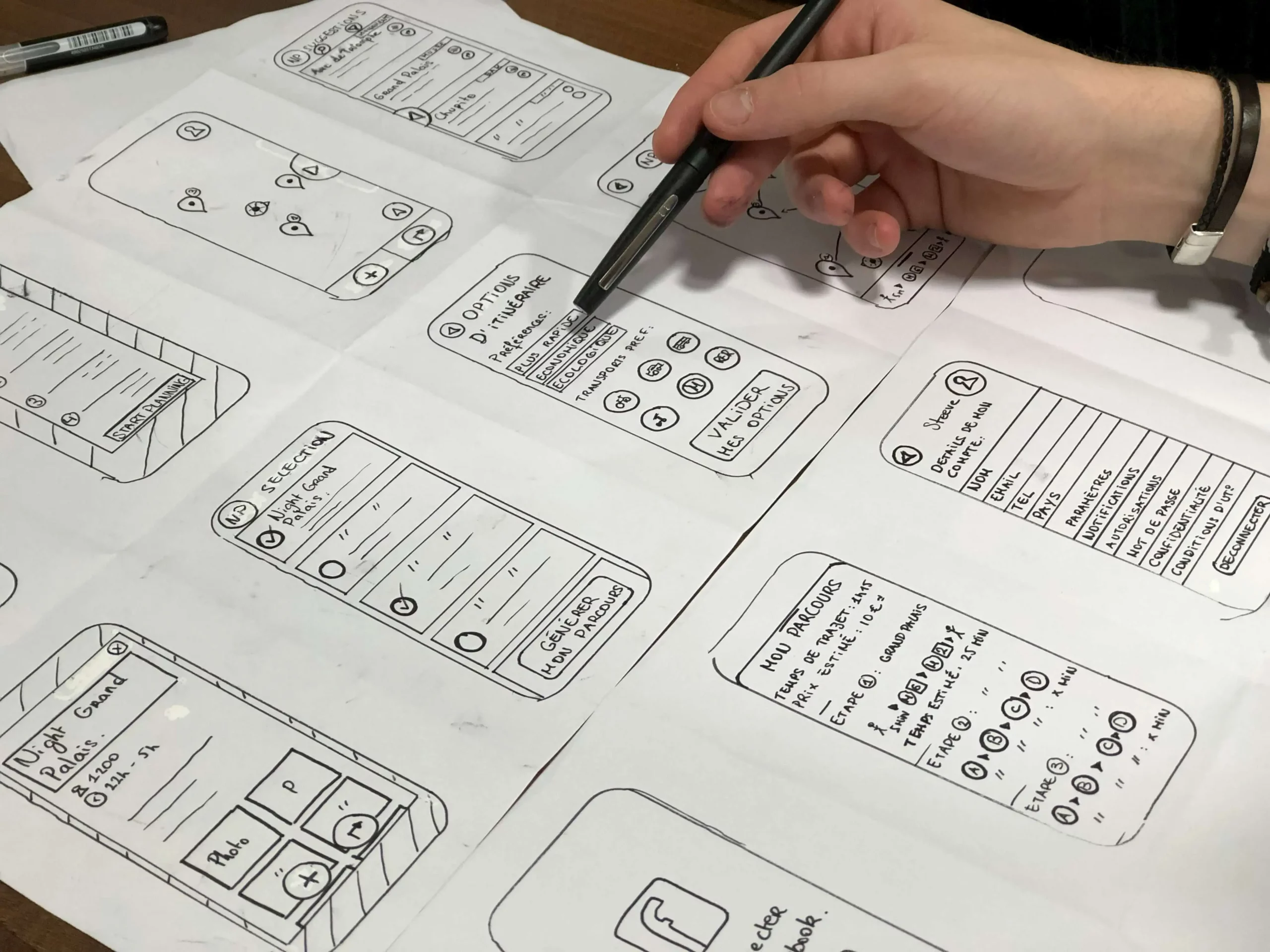
Your website is your salesman 24/7, and as such, it can be the most powerful marketing tool at your disposal. A well-designed site with a clear message will make potential customers want to buy from you right away! Today we are going to talk about 7 steps to improve user experience with your web development process.
Yes, you’ve read it right.
Successful web development today is about much more than just coding and design. It’s about creating an online presence that enhances a brand, generates revenue, and connects with customers in a way that delights them.
What Is UX?
User Experience Design, or UX Design, is the process of enhancing user satisfaction with a product by improving its usability and accessibility. The goal of a UX Designer is to make a website or application that is easy to use.

By improving usability and accessibility, UX Design can help increase user satisfaction and improve sales.
However, UX is not just about making things look good but also removing frustration and roadblocks that make users want to go elsewhere.
With Web development growing from its early days of simple HTML forms into complex website designs with state-of-the-art dynamic technology right in your browser experience – UX designers have their work cut out for them!
When we used to build basic websites using traditional methods, the process was easy. However, modern web development came with challenges that made the process more complicated for both developers and clients alike – there’s not just one way to do things anymore!
But you can follow these seven simple steps to make the process less daunting for all the parties involved.
1. Digital Strategy
You need a strategy that will help you understand your customers better and provide the right content at just-in-time moments.
A digital strategy includes developing a brand identity, website design, mobile app development, and content marketing.
The essence of a digital strategy is understanding how your users think and what they need to accomplish. Your user experience can be the key that unlocks customer retention, conversion rates, or even higher satisfaction in general for your business.
In order to make sure you’re giving your visitors the best experience possible, implement these digital strategies into your process:
- Responsive and mobile-friendly website.
- Make sure you have social media integrations.
- Implement a strong SEO strategy.
- Utilize analytics tools.
2. Plan And Design The Website Using A Dynamic Framework
Every dynamic website is built from a framework that helps the user visualize and manage information on the site. This makes it easy for developers to create database-driven web pages, making the user experience of browsing through each page interactive in nature!
Yes, giving the user an optimized experience from day one is important. Especially when you’re building a web application or are using custom technology that hasn’t been introduced before. This can help them get more out of their visit and lead to higher conversion rates for your business.
The right design brings together all of these technologies into one cohesive interface that works beautifully while still being simple enough for users to pick up right away without much effort on your part. There are many frameworks available today that can help in this process.
Web developers can choose from various dynamic frameworks available in the market. The framework will help you visualize and manage information and create database-driven web pages on your website.
JQuery is the most popular right now, but other frameworks are popping up regularly that may fit your business model in unique ways.

3. Integrate Web Applications:
When developing your website, it is important to consider integrating dynamic content such as hidden applications or widgets that allow you to track visitor behavior, connect with customers via social media, and experience for each user right on the website.
This will allow users to explore different aspects of your brand right from the home page without being forced into anything they don’t want to do right away.
Technologies, such as Google Analytics and social media widgets, can be easily implemented right into your design. Others may require custom coding done by the right web development services agency, so they fit seamlessly with your website’s structure.
4. Load Dynamic Content
Web developers must ensure the right content is displayed to the right users at the right time to keep them engaged.
It’s better to make sure that all of the information you want to share is presented so as not to overwhelm the users. This might take some work, especially if you have a lot of products or services for sale right from the home page. But it can definitely be done well when you know what you are doing.
Most websites use content management systems (CMS) to manage and display dynamic content. A CMS allows you to create, edit, and manage web pages without any programming knowledge.
So, make sure your web development services agency understands your business model right from the start. It’s also important to give them examples of websites that you like right from the design process so they can build off of existing ideas and make them work even better for you right away.
5. Use Web Testing Tools
Web testing tools come in handy when Web developers have to test their websites. These Web testing tools can help you reduce costs, turnaround time, and errors by increasing the quality of their web applications, designs, and coding.
You can keep the users engaged on your website by adding testing right into their design with A/B tests, multivariate tests, etc. These are essential for making any changes to your website right away without going through a costly redesign process or extensive testing period before deploying new designs, widgets, or applications right onto your website live for everyone.
6. Page Loading Time
Page loading time is a crucial factor in user experience.
The speed at which the page loads indicates how fast the web app functions and how many resources it uses.
In order to improve the user experience, developers need to focus on improving the speed at which their website loads while utilizing different methods like ad blocking, caching, and compression.
It would be beneficial if they use the PageSpeed Insights tool by Google Chrome browser – this tool provides recommendations that can help improve the performance of any website.

7. Track User Behavior
Web development companies can track user behavior on their website using Web analytics software such as Google Analytics. As a website development company, we do a great job with this.
You can track where the traffic is coming from, how long people are staying on each page, what links they click on, where they are dropping off in the buying cycle – basically anything that you might want to know about your website right now.
You can use this information to ensure that your site brings customers in and converts them into buyers right away without wasting time and resources. You can figure out any problems that could be slowing down your traffic and revenue potential.
To sum up
You can improve the user experience by following these five simple steps. You can also use Web 2.0 technologies to provide a richer user experience.
The right web development services agency and development process will encompass all of these right tools and techniques right from the beginning to ensure that you’re getting your money’s worth right off the bat. If there is anything wrong with your website right now, this information can give you a leg up on improving it right away.
When you know what you want out of your website, it can be easy to find those right tools online or through an agency that understands how to put them together in the right way.
Some FAQs About User Experience And Website Development
Desirable: Image, identity, brand, and other design elements are used to evoke emotion and appreciation. Findable: Content needs to be navigable and locatable onsite and offsite. Accessible: Content needs to be accessible to people with disabilities. Credible: Users must trust and believe what you tell them.
User experience describes how people feel when navigating a website, using a mobile app, or otherwise interacting with a company’s digital products or services. There are many elements that contribute to designing for exceptional user experiences, such as user interface, usability, and user research.
In other words, UX design is the process of designing (digital or physical) products that are useful, easy to use, and delightful to interact with. It’s about enhancing the experience that people have while interacting with your product, and making sure they find value in what you’re providing.
Consistent and unified design elements, which provide a clear visual presentation, can help to gain the trust of a user. A sense of trust builds up and the audience starts believing you as a reliable company. A web design can create an emotional connection between the user and your brand.
Interaction designers are focused on the moment when a user interacts with a product and their goal is to improve the interactive experience. User experience design accounts for all user-facing aspects of a product or system. Interaction design is a part of UX design.
Contact Matchbox Design Group Today!
If your website could use a refresh or you’re looking to drive more traffic to your site, fill out the form below and we’ll contact you to learn more about your digital needs.

